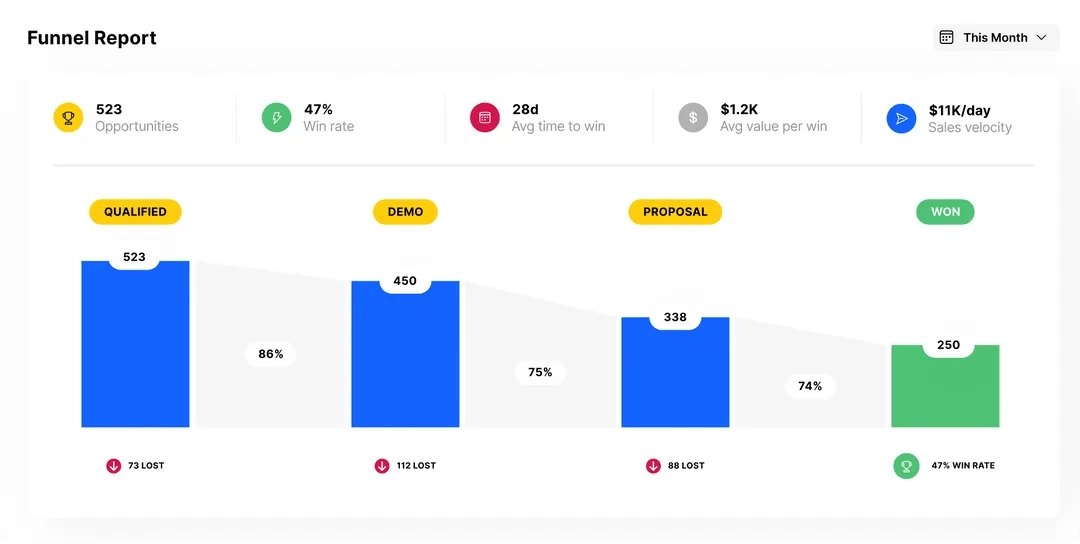Ready for a pop quiz on leads vs prospects?
What’s the difference between a name you found on LinkedIn, a contact you sourced through your company’s chatbot, and a decision-maker with whom you’ve had several phone calls?
If you answered “their stage on the buyer’s journey,” then you get a gold star. (We’re sending it right now, telepathic-like.)
Another way to think about each of these examples is where they are in the sales funnel. From a lead to a prospect to a sales opportunity, each person has different wants, needs, pain points, and suspicions. You must be able to recognize a lead vs. prospect vs. opportunity if you hope to nurture each customer relationship in the sales cycle.
For example, let’s say you sell ink cartridges, and Cara from Omaha is a purchaser of a 500-person company. What does she need from you?
Well, if she’s starting her search, then constant outreach might prove unwelcome. She needs time and information at this point. On the other hand, if she’s getting ready to make a purchase and you’re MIA, that’s a missed sale. The critical point here? You need to know which part of the funnel Cara is in and treat her accordingly, or else you’ve got yourself a leaky funnel.
This is true no matter your industry or company size. So, if there’s one thing you can do to improve your prospecting game today, it’s this: help your sales reps understand the critical difference between a prospect and a lead. That’s what we’re going to look at today.
What is a Prospect?
Prospects can be identified via any sales prospecting activities in which you search for possible customers at the lead and prospect levels. And once you find the right prospects, they’re worth reaching out to. Make every effort to engage your prospects and get them started in the lead qualification process. You can do this in multiple ways, including:
- Cold calls, where you present your product and gauge their immediate interest level
- Email automation sequences that deliver useful information and pique their interest
- Reach out via direct messages or on someone’s social media page
Once you contact your prospect, you’ll attempt to intrigue them enough to become a lead and join the top of the funnel. But even if your prospect isn’t interested right now, with enough continuous outreach (slightly scaled back), you’ll position yourself to be top of mind when your prospect is ready for your product or service.
Ready to take your leads to the next level? Don't miss our article on strategic real estate prospecting.
What is a Lead?
The main difference between a prospect and a sales lead is that contact hasn’t been made with the former. With the latter, you know they’re the right demographic and buyer persona for your products—both stages in the sales process matter.
Let’s take Cara again as an example. Perhaps she came to you via your inbound marketing team, a trade show, a cold phone call campaign, or another type of lead generation outreach. She has a new awareness of your company and is ready to learn more, such as pricing or customization. She is a lead, and it is time to proceed with your sales strategy.

The 3 Types of Leads
To fully understand lead vs. prospect and boost your sales process, you need to understand the difference between the three types of leads. This will clarify the sales process and allow you to gather intent data and score your leads.
Information Qualified Leads (IQLs)
This lead has provided their contact information in return for “free” content you’re giving away. Of course, it’s not free because you now have the ability to nurture them through warm calling, email, and other activities in which sales teams typically engage.
Marketing Qualified Leads (MQLs)
An MQL has indicated an interest in your product. Perhaps they heard you out during a cold call, emailed to ask questions, or clicked on an online ad. MQLs have a good chance of becoming a customer.
Sales Qualified Leads (SQLs)
Once a lead is sales-qualified, it has passed through both marketing and sales and has been determined as a viable fit for the company’s products or services. At this point, it can pass into the prospect stage.
Attention marketers! Discover the differences between MQL vs. SQL in our latest piece.
What is a Sales Opportunity?
Note: Sales opportunities are also referred to as sales prospects or potential customers.
At this point, your sales team is in contact with the prospect and going through the steps of your sales process, including delivering a sales pitch, presenting a product demo, and negotiating with stakeholders.
Going back to our example with Cara above, after she chats with the sales team and they’ve determined that it’s a good match, you’ll continue to negotiate with her about the price and quantity of ink cartridges that her company needs. She’ll remain an opportunity until either she decides not to purchase or she becomes a customer.
The 3 Levels of Qualification for Opportunities
There are three levels of qualification through which you need to move the opportunity to become a sale.
Organization Level Qualification
At the organization stage, it’s your job to make sure the opportunity matches the key characteristics of your products or services.
That includes whether you’re in the right place to serve them, whether they meet your demographic parameters, and, for B2B sales, whether their company is aligned with yours. These are all aspects you should uncover now if gaps are remaining from the prospecting and discovery stage.
Opportunity Level Qualification
The next step in assuring someone is a quality prospect is to ensure they can use your product or service. Trying and selling something is unfair if it doesn’t address their pain points. Again, the salesperson is responsible for ensuring the fit is good.
Stakeholder Level Qualification
Okay, so they’re interested… but do they have the authority to close the deal with you? You can feel free to ask them this point-blank. Most likely, if they believe in your product and in working with you, they’ll have no problem directing you to the right decision-maker and making an introduction.
How to Turn a Prospect Into a Lead
Now that we’ve looked at the basic lead vs. prospect journey, let’s drill deeper into what gets you to that most joyous of occasions: closing a deal. First, you must turn your prospect (the potential customer who hasn’t engaged with your company yet) into a lead (a qualified prospect who is now in your sales funnel). Here are three ways to do just that.
Ensure Contacts Match Your Ideal Customer Profile
When you design customer profiles, you clarify who is a good fit for your company’s products and your target market. When you write out each (and each buyer persona) with specific demographic data, you make it less likely that someone will walk away from a deal or be unhappy with your product later.
Hence, customer profiling – such as what the Close CRM (customer relationship management) system enables – is a great first step in converting leads into prospects.
Actively Engage in Lead Qualification
Next, get as much data as you can on your lead. Collect it from a form they use to download a piece of gated content, a mailing list, their LinkedIn profile, other social media platforms, or anywhere else you can. Then, input this into your CRM and bucket it into specific categories.
Use custom fields to include additional notes. Then, you can use this data to segment your automation, email marketing strategy, follow-up calls, and more.

Begin Your Lead Nurturing Process
Now, it’s time to nurture your lead. These marketing efforts help influence a purchasing decision with valuable information to the prospect, thoughtful touchpoints that make them trust you, and gentle pushing toward gathering even more info.
How to Turn a Prospect into an Opportunity
Now that we’ve discussed lead vs prospect, it’s time to expand your knowledge. Let’s shift over and look at prospect vs opportunity, the next jump in the nurturing game.
Once you’ve completed the qualification process and have identified your lead as a good prospect (or potential customer), you can begin taking your prospect through the sales process stages. That’s when they become an opportunity, someone more than interested and nearly ready to take the plunge with you.
Want to get them there? Here are our two favorite strategies for how to execute turning a prospect into an opportunity:
Communicate with Your Prospects
Unfortunately, you can’t talk to every lead in your pipeline, even qualified leads. You don’t have the right contact information for some of them. For others, they’re simply not biting—not picking up the phone, not responding to those emails, not hitting you back on DMs.

But prospects? Prospects are different. You have their info, you’ve communicated before, and they’ve given you solid reasons to believe your advances are welcome. Once you’ve gotten to that stage, you should keep communicating regularly by:
- Making follow-up phone calls as many times as necessary unless they specifically tell you to stop
- Adding them to your automated email sequence so you can communicate with them without having to think about it
- Check-in on the old socials
Prospect Nurturing
Similar to lead nurturing, prospect nurturing is a process whereby you give the prospect the tools they need to move forward with your business. Those tools will differ depending on your product or service, but your main goal is to:
- Provide the necessary information they’ll need when using your offerings
- Empowering their decision-making by answering questions about your products or services
- Tracking them carefully in your CRM so you remember all the pertinent details
- Maintaining a sense of excitement about it all
This is where you bring to completion the sequence of sales lead to sales prospect to sales opportunity. Once the qualification process has progressed this far, you’re at the bottom of your funnel, and you can expect them to decide soon. Hallelujah, you’ve worked hard to get here!
Remember, even when a hot prospect turns cold, it’s not the end of the cycle. Just keep pursuing them politely, answer their questions, and provide support. Before you know it, they may say yes.
Final Thoughts: Leads vs. Prospects vs. Opportunities in the Real Sales World
Although the lead vs prospect debate might have initially seemed semantic, it’s a pretty important distinction.
The value of identifying the difference between prospect and lead lies in giving them the proper treatment to meet them where they’re at on the buyer’s journey.
Push a lead too hard, and they’re out; fail to nudge a prospect enough, and you lose them. It’s all about the right touch—and the right touchpoints—at the right time. If you can turn a lead into a prospect, then chances are excellent that you can turn that prospect into a sale. The above strategies are, therefore, absolutely critical to the entire cycle.
Need a reliable, all-in-one way to keep track of your leads, prospects, opportunities, and customers? That’s where Close comes in. Trusted by a huge range of businesses, Close can effectively manage the entire outbound sales process as well as provide sales teams with accurate data measurement and reporting for further improvement.
If you’d like to learn more, watch our 10-minute on-demand software demo or browse our many free resources today.
Ready to go? Try Close free for 14 days.












